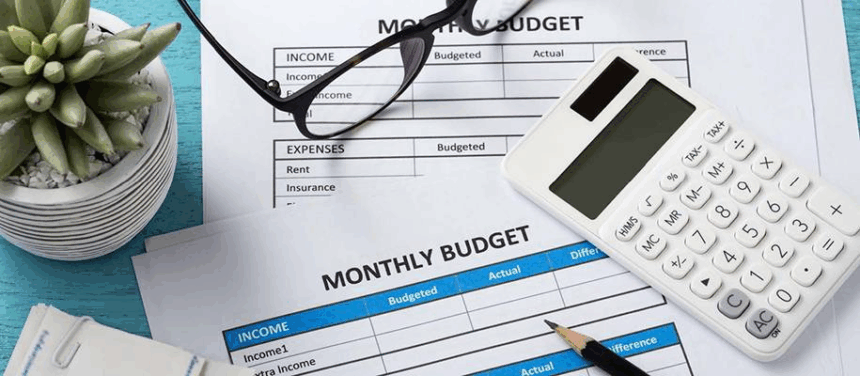Managing your money can feel overwhelming, especially when expenses keep popping up unexpectedly. Many people create budgets that look good on paper but fail in real life because they’re too strict, unrealistic, or not regularly updated. The key to success isn’t just creating a budget—it’s making one that actually works for your lifestyle.
In this guide, you’ll learn practical steps to build a monthly budget that helps you take control of your finances, reduce stress, and make steady progress toward your financial goals.
1. Understand Why You Need a Budget
Before you start crunching numbers, it’s important to understand why budgeting matters. A monthly budget acts like a roadmap for your finances—it shows where your money is going and helps you stay on track.
A good budget helps you:
- Avoid overspending
- Save for future goals
- Pay off debt faster
- Prepare for emergencies
- Gain peace of mind about your money
Without a plan, money tends to disappear on small, unnoticed expenses like takeout meals or impulse shopping. When you budget, you take back control of your financial life.
2. Calculate Your Total Monthly Income
The first step to building a working budget is knowing exactly how much money you have coming in. This includes:
- Salary or wages (after taxes)
- Freelance or side gig income
- Rental income
- Bonuses or commissions
- Investment returns
If your income fluctuates each month, take the average of the last 3–6 months to get a realistic number. Always budget based on your lowest average income to ensure you don’t overspend during slow months.
3. Track Your Expenses for 30 Days
You can’t fix what you don’t measure. Spend one month tracking every expense, from your rent to your coffee runs. Write it all down or use budgeting tools like Mint, YNAB (You Need A Budget), or Google Sheets.
Divide your spending into categories such as:
| Category | Examples |
|---|---|
| Housing | Rent, mortgage, utilities |
| Transportation | Gas, car maintenance, public transit |
| Food | Groceries, dining out |
| Personal | Clothing, entertainment, subscriptions |
| Health | Insurance, medications |
| Debt | Credit cards, loans |
| Savings | Emergency fund, retirement contributions |
By the end of the month, you’ll see where your money actually goes. Many people are surprised by how much they spend on small things like coffee or streaming services.
4. Set Clear and Realistic Financial Goals
Your budget should align with your goals. Think about what you want to achieve financially over the next year or two. Maybe you want to:
- Build an emergency fund
- Pay off credit card debt
- Save for a vacation
- Buy a car or home
- Start investing
Write down your goals and assign a timeline to each one. This gives your budget a sense of purpose. For example:
“Save $3,000 in 12 months for an emergency fund”
“Pay off $5,000 in credit card debt within 10 months”
Once you know your goals, you can adjust your spending habits to make them happen.
5. Use the 50/30/20 Rule (or a Custom Formula)
A simple way to structure your monthly budget is with the 50/30/20 rule:
- 50% for needs: Rent, utilities, groceries, transportation, insurance
- 30% for wants: Entertainment, dining out, hobbies, vacations
- 20% for savings and debt: Emergency fund, investments, loan payments
If this formula doesn’t fit your situation, you can tweak it. For example, if you’re trying to pay off debt aggressively, you might use 60/20/20 or 70/10/20, putting more toward debt repayment or savings.
6. Plan for Irregular and Seasonal Expenses
Some expenses don’t occur every month, like car registration, holiday shopping, or annual insurance premiums. To prevent these from wrecking your budget, plan for them ahead of time.
Here’s how:
- List all your irregular expenses.
- Estimate their annual total.
- Divide that by 12 to find the monthly amount to save.
For example, if you spend $1,200 a year on holiday gifts, put aside $100 each month into a separate “holiday fund.” When the season arrives, you’ll already have the money ready.
7. Automate Your Finances
Automation is a powerful way to make your budget work without constant effort. Set up automatic transfers for:
- Savings → Move a fixed amount to your savings account right after payday.
- Bills → Use auto-pay to avoid missed payments.
- Investments → Automate contributions to your retirement or brokerage account.
This approach ensures your financial goals are prioritized before you’re tempted to spend on non-essentials.
8. Review and Adjust Your Budget Monthly
Your first budget won’t be perfect—and that’s okay. Life changes, and so should your budget. At the end of each month:
- Compare your actual spending vs. planned spending.
- Identify where you went over or under.
- Adjust your next month’s plan accordingly.
For example, if groceries consistently cost more than expected, increase that category and reduce another (like entertainment). Flexibility keeps your budget sustainable over time.
9. Build an Emergency Fund
Unexpected expenses are inevitable—car repairs, medical bills, or job loss can happen anytime. That’s why every effective budget includes an emergency fund.
Start small with a goal of saving $500–$1,000. Over time, build it up to cover 3–6 months of living expenses. Keep it in a separate, easily accessible account. This safety net will prevent you from going into debt during tough times.
10. Stay Motivated and Reward Yourself
Budgeting isn’t about restriction—it’s about empowerment. If you stick to your budget, allow small rewards to celebrate progress. Treat yourself to a nice dinner, a movie, or something you’ve been wanting (within reason).
You can also stay motivated by tracking your goals visually. Use charts, spreadsheets, or budgeting apps that show your savings and debt payoff progress. Watching your hard work pay off keeps you focused.
Conclusion
Creating a monthly budget that actually works is less about strict rules and more about awareness, balance, and consistency. When you understand where your money goes, set realistic goals, and adjust regularly, you’ll start feeling in control of your finances—rather than controlled by them.
A good budget isn’t about depriving yourself—it’s about giving your money a purpose. Whether you’re saving for your dream vacation, building a safety net, or working toward financial freedom, the right budget can make it happen.
Frequently Asked Questions (FAQs)
1. How do I stick to my budget every month?
Start small. Don’t try to cut everything at once. Use budgeting apps to track expenses and set automatic savings transfers so you don’t have to rely on willpower alone.
2. What should I do if my income changes often?
If your income fluctuates, base your budget on your lowest expected monthly income. During higher-earning months, save the extra to cover slower months or unexpected expenses.
3. How much should I save each month?
A good rule of thumb is to save at least 20% of your income. If that’s not possible, start with 5–10% and gradually increase as your finances improve.
4. How can I reduce unnecessary expenses?
Review your monthly subscriptions, limit impulse spending, cook at home more often, and set spending limits for entertainment or dining out. Small cuts can lead to big savings.
5. Do I need budgeting apps or can I use paper?
Either works! Some people prefer digital tools like Mint or YNAB for convenience, while others like the simplicity of pen and paper. Choose whatever system helps you stay consistent.
Final Tip:
A monthly budget is not about perfection—it’s about progress. Review it regularly, make small improvements, and stay committed to your goals. Over time, you’ll develop better money habits and achieve true financial stability.










